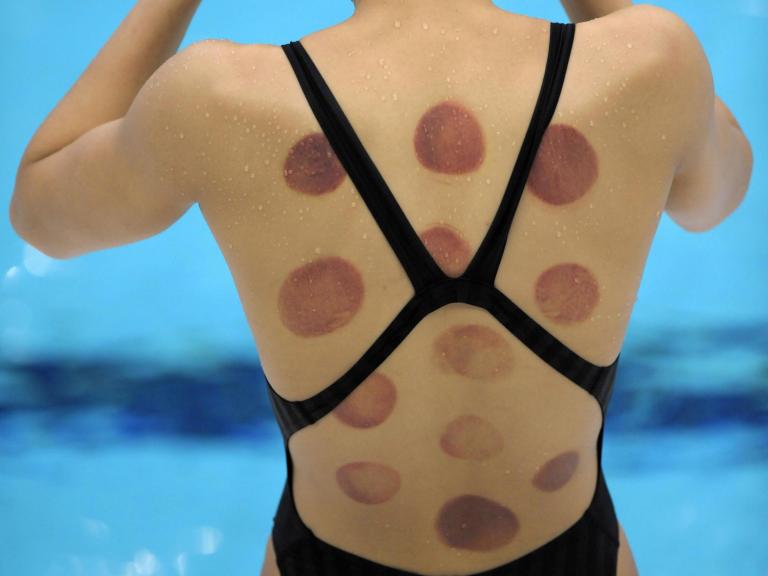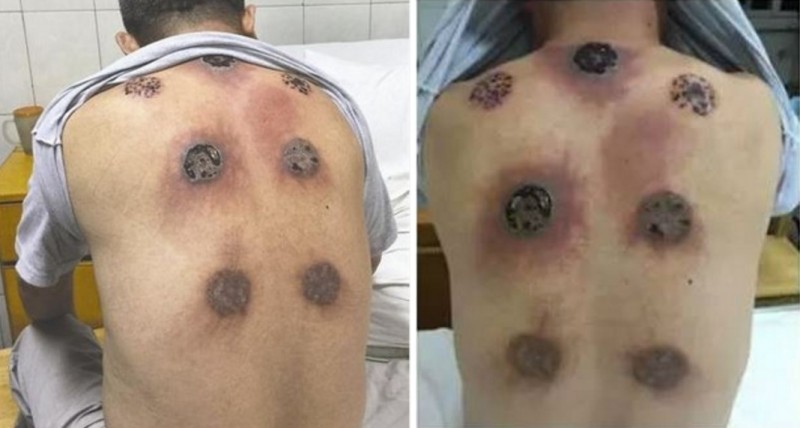I’ve written before about so-called Traditional Chinese Veterinary Medicine (TCVM). It is the adaptation for veterinary patients of a hodgepodge of pre-scientific folk theories and practices cobbled together for largely political reasons by Mao in the 20th century. The most popular TCVM therapy is acupuncture, which I have discussed in exhaustive detail many times. TCVM herbal therapies are also fairly common, and its variety of massage (Tui Na) as well as some dietary practices are sometimes recommended by TCVM practitioners, though they have not become as common outside this community as acupuncture.
There is one Chinese Medicine treatment that I haven’t discussed before, largely because I had never heard of it being used in veterinary patients: cupping. Cupping has had a moment in the limelight lately because it is the alternative medicine fad du jour among some Olympic athletes this year (much as kinesio taping was in 2012, though that seems less popular this year.
Cupping is basically the practice of placing a glass or plastic container on the skin and creating a partial vacuum, with heat or a suction pump. Sometimes, the skin under the cups is cut or scarified (so-called “wet cupping”) to induce bleeding. This leaves a visible bruise, which is often impressive, and is supposed to prevent or treat injury by increasing blood flow, expelling toxins, moving Ch’i, or any of a number of other purported mechanisms. Others have written about cupping, explaining why it is implausible in theory and entirely unproven in practice. And though it is probably mostly harmless, it can be the cause of serious injury if improperly done.
After the news media starting discussing cupping by Olympic athletes, I was asked about the use of this practice in veterinary patients. I had assumed it would not be practical since most of my patients are covered in hair, which would impede the creation of a seal necessary for generating a partial vacuum. Unfortunately, even I had underestimated the lengths to which some TCVM practitioners will go to inflict their methods on animal patients. Here is an example of a dog subjected to cupping.
 There is even a video of this being done to an apparent wound on a horse.
There is even a video of this being done to an apparent wound on a horse.
To be fair, cupping does seem pretty uncommon even among TCVM practitioners however, there are references to it on practice web sites along with acupuncture and other TCVM therapies, and lectures on cupping have been given at a number of continuing education conferences for alternative medicine vets (e.g. from the Ch’i Institute, the leading organization teaching and promoting TCVM, and the American Academy of Veterinary Acupuncture and International Veterinary Acupuncture Society joint conference).
So once again, while it shouldn’t need to be said:
There is no legitimate evidence that cupping is effective for any medical condition in any species.
- Human patients report it to be moderately uncomfortable, so there is no excuse for applying to animals who cannot give their consent to a painful procedure when there is no reason to believe there will be any benefit.
- It can cause serious injury, and while this appears to be rare it is not a risk that it makes any sense to take when, once again, there is no good reason to believe it has any benefits.












the hickeys I got on my neck as a teenager did wonders for my health
Cupping was very popular in Soviet Russia when I was growing up. No mention was made of Ch’i; rather, the suctioning was supposed to literally pull the illness (usually ‘flu) out of the person. When it comes to superstition, we Russians will leave TCM in the dust 🙂
This is animal abuse. They should throw the book at those who do this kind of thing.
Cupping an animal is straight up abuse.
First cupping death in the news this morning
http://www.msn.com/en-us/health/wellness/a-17-year-old-boy-died-after-getting-a-hickey/ar-AAig6S1
As a Licensed Massage Therapist who uses cupping quite often (and has it done quite often), I can assure people that it is not abuse and is actually quite effective in reducing muscle pain, muscle tension, muscle stiffness, and muscle scar tissue and adhesions. When the cups are put on the skin it it relatively painless if not completely painless. The most a person and/or animal will feel is pressure as if someone was pushing on the area, but not pushing so hard as it is painful. At most, there is some mild discomfort unless they are used wrong, or by someone who lack experience. The marks left are just from blood being pulled and pooled into the area (which is actually very good for muscles; especially ones that are prone to developing scar tissue, adhesion, and stiffness). The way the cups pool blood into an area reduces muscle stiffness by increasing circulation and opening up muscle fibers. Muscle fibers often go stagnant and often will bind togther which reduces the amount of blood moving through the muscle and can increase the risk of injury. The cups will also lift the muscle tissue reducing muscle tension, and breaking up abnormal scar tissue and adhesions in an area; which promotes good muscle health. Often times in my practice I find that if a patient has a muscle that is very tight and/or stiff, touching the area with even medium or light pressure can be painful while they are getting their massage. Often times I and many other Massage Therapists will put a cup over the muscle so the patient does not have to deal with the tenderness to touch as the cups are relatively painless; and infact a lot of my patients request the cups when I find areas like this while I am working on them. All in all, cups are a good alternative for relieving muscle pain, tenison, stiffness, scar tissue, and adhesions (especially if work is being done on a very tender muscle or area of the body). They are not abuse. The marks they leave are much worse than the actual feeling they can create while being used.
Unfortunately, all you offer is your opinion and personal anecdotes, and that kind of evidence has been deeply unreliable throughout the history of medicine. There is no scientific evidence this folk remedy does any good at all.
Why Anecdotes Can’t Be Trusted
To the “advocate” above:
In pets, it IS abuse, so no matter what your personal opinions are, it doesn’t change that glaring fact. Animals cannot tell us what is or what is not hurtful to them, and to state that you’re not causing discomfort, is dishonest.
I agree with ‘cupping therapy advocate’. I have had cupping on my back performed by my acupuncturist. I took CMFT, Canine/small animal massage therapy training and we had a section on cupping, I use silicon ones. This was to decompress tissues and if you have facia that is stuck, you can use these pods while attached to gently move around the tissues. The recommended time is 15-20 seconds up to 30-90 seconds. The skin may be pink underneath but never bloody looking. The animals seem fine with it. The individual training us is a veterinarian and chiropractor. Like the various massage techniques out there, I see this as another way to invite bloodflow and healing and decompress tissues.
Unfortunately, there is no evidence beyond anecdote for any of these rationales. “Stuck fascia” is not a meaningful physiologic diagnosis, and I have not found any clinical studies in dogs or cats showing any benefits for cupping, so all we have so far is dubious theory and personal experience. I get that most people find their personal experiences to be sufficient proof, but unfortunately that misconception is behind every failed medical therapy ever tried, and scientific research is really needed to support such claims.
Then do a scientific study and provide the evidence of it NOT working ?
That’s not how science works. You make the claim, you provide the evidence for the claim. Nobody needs to take your claim seriously until you do the work to prove it.
“Human patients report it to be moderately uncomfortable”
As a TCM Practitioner, with years of Cupping Therapy experience, this statement is absolutely false. Cupping is comfortable & provides numerous benefits!
Well, plenty of patients would disagree with you (for example), but dealing anecdotes isn’t a useful game to play. Controlled research evidence shows that there are risks to cupping, and the benefits you think you see are just as unproven and anecdotal as for most TCM practices, so until you can provide high-quality controlled clinical research to support your claims, they are just expressions of your beliefs, not objective data anyone is obliged to accept as probative.
Why Anecdotes Can’t be Trusted
Skeptvet,
We live in a society now where there is only one frame of thoughts that is accepted and anything outside the box is considered anecdotal and ridiculed or diminished. As a scientist and a PhD in biology, I can assure you that the scientific framework of the 21rst century is extremely limited and does not allow for testing of indirect effects of a procedure of treatment. We are only able at the moment to measure direct causal effects that are statistically significant (with all the controversy attached to this). Science didn’t used to be so close minded but now it just wants to simplify and put the natural world into boxes. Rejecting people’s statements closes the door to important discoveries. It’s probably just a phase, we are seeing more and more that this framework is obsolete. I am hopeful that I can witness science open its mind again in my lifetime.
Sorry, but that is a mix of the obvious and the untrue.
1. Of course science is imperfect and limited in its ability to help us develop accurate understanding and predictive models of nature. It’s simply far better than anything else we have yet tried. The tangible and dramatic improvements in health and well-being that have come as a result of using science in preference to personal experience, intuition, faith, tradition, etc. are enormous and make the case quite convincingly that this is the best game in town.
2. There are many methodological ways to measure association, so it is false to say we only measure direct causal relationships. There are also many ways to evaluate and understand the contributions of multiple factors responsible for a given effect, to account for confounding, and to look comprehensively at the context in which natural phenomena occur. This straw man of hyper-reductionism is manufactured and does not accurately represent how scientific and medical research work.
3. “Rejecting people’s statements closes the door to important discoveries.” Nonsense. No one is rejecting observations as source of testable hypotheses. What science-based medicine rejects is anecdote as proof of these hypotheses. We don’t close doors without evidence, but we don’t walk through them without good evidence either.
Pingback: WSAVA Adds Chinese Medicine Pseudoscience to Continuing Education Conference Held in China |